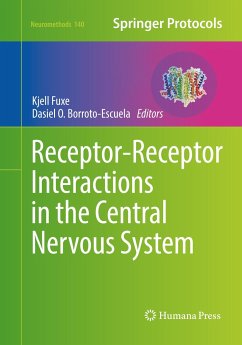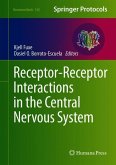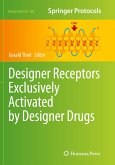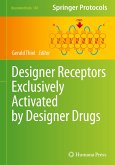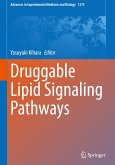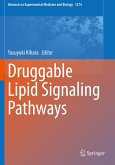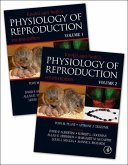Receptor-Receptor Interactions in the Central Nervous System
Herausgegeben:FUXE, KJELL; Borroto-Escuela, Dasiel O.
Receptor-Receptor Interactions in the Central Nervous System
Herausgegeben:FUXE, KJELL; Borroto-Escuela, Dasiel O.
- Broschiertes Buch
- Merkliste
- Auf die Merkliste
- Bewerten Bewerten
- Teilen
- Produkt teilen
- Produkterinnerung
- Produkterinnerung
This volume covers methodologies, ranging from the molecular level to the network level, used to study receptor-receptor interactions in heteroreceptor complexes inside the central nervous system. The chapters in this book cover topics such as biochemical binding techniques; receptor autoradiography; superfused synaptosome techniques; RTK-GPCR interaction; fluorescence and bioluminiscence energy transfer methods, Co-IP cytometry-based FRET; and novel bioinformatic approaches to understand membrane heteroreceptor complexes and the global panorama of their receptor-receptor interactions. In…mehr
Andere Kunden interessierten sich auch für
![Receptor-Receptor Interactions in the Central Nervous System Receptor-Receptor Interactions in the Central Nervous System]() Receptor-Receptor Interactions in the Central Nervous System121,99 €
Receptor-Receptor Interactions in the Central Nervous System121,99 €![Designer Receptors Exclusively Activated by Designer Drugs Designer Receptors Exclusively Activated by Designer Drugs]() Designer Receptors Exclusively Activated by Designer Drugs57,99 €
Designer Receptors Exclusively Activated by Designer Drugs57,99 €![Designer Receptors Exclusively Activated by Designer Drugs Designer Receptors Exclusively Activated by Designer Drugs]() Designer Receptors Exclusively Activated by Designer Drugs81,99 €
Designer Receptors Exclusively Activated by Designer Drugs81,99 €![Breathing, Feeding, and Neuroprotection Breathing, Feeding, and Neuroprotection]() Breathing, Feeding, and Neuroprotection41,99 €
Breathing, Feeding, and Neuroprotection41,99 €![Druggable Lipid Signaling Pathways Druggable Lipid Signaling Pathways]() Druggable Lipid Signaling Pathways121,99 €
Druggable Lipid Signaling Pathways121,99 €![Druggable Lipid Signaling Pathways Druggable Lipid Signaling Pathways]() Druggable Lipid Signaling Pathways121,99 €
Druggable Lipid Signaling Pathways121,99 €![Knobil and Neill's Physiology of Reproduction Knobil and Neill's Physiology of Reproduction]() Knobil and Neill's Physiology of Reproduction540,99 €
Knobil and Neill's Physiology of Reproduction540,99 €-
-
-
This volume covers methodologies, ranging from the molecular level to the network level, used to study receptor-receptor interactions in heteroreceptor complexes inside the central nervous system. The chapters in this book cover topics such as biochemical binding techniques; receptor autoradiography; superfused synaptosome techniques; RTK-GPCR interaction; fluorescence and bioluminiscence energy transfer methods, Co-IP cytometry-based FRET; and novel bioinformatic approaches to understand membrane heteroreceptor complexes and the global panorama of their receptor-receptor interactions. In Neuromethods series style, chapters include the kind of detail and key advice from the specialists needed to get successful results in your laboratory.
Cutting-edge and thorough, Receptor-Receptor Interactions in the Central Nervous System is a valuable resource for any scientist or researcher interested in this field of study.
Cutting-edge and thorough, Receptor-Receptor Interactions in the Central Nervous System is a valuable resource for any scientist or researcher interested in this field of study.
Produktdetails
- Produktdetails
- Neuromethods 140
- Verlag: Humana / Springer New York / Springer, Berlin
- Artikelnr. des Verlages: 978-1-4939-9331-4
- Softcover reprint of the original 1st edition 2018
- Seitenzahl: 368
- Erscheinungstermin: 10. Dezember 2019
- Englisch
- Abmessung: 254mm x 178mm x 20mm
- Gewicht: 704g
- ISBN-13: 9781493993314
- ISBN-10: 1493993313
- Artikelnr.: 57078378
- Herstellerkennzeichnung Die Herstellerinformationen sind derzeit nicht verfügbar.
- Neuromethods 140
- Verlag: Humana / Springer New York / Springer, Berlin
- Artikelnr. des Verlages: 978-1-4939-9331-4
- Softcover reprint of the original 1st edition 2018
- Seitenzahl: 368
- Erscheinungstermin: 10. Dezember 2019
- Englisch
- Abmessung: 254mm x 178mm x 20mm
- Gewicht: 704g
- ISBN-13: 9781493993314
- ISBN-10: 1493993313
- Artikelnr.: 57078378
- Herstellerkennzeichnung Die Herstellerinformationen sind derzeit nicht verfügbar.
Analysis and Quantification of GPCR Allosteric Receptor-Receptor Interactions using Radioligand Binding Assays: The A2AR-D2R Heteroreceptor Complex Example.- Analysis and Quantification of GPCR Heteroreceptor Complexes and their Allosteric Receptor-Receptor Interactions using Radioligand Binding Autoradiography.- On the Study of D4R-Mor Receptor-Receptor Interactions in the Rat Caudate Putamen: Relevance on Morphine Addiction.- Use of Superfused Synaptosomes to Understand the Role of Receptor-Receptor Interactions as Integrative Mechanisms in Nerve Terminals from Selected Brain Region.- Detection of Fibroblast Growth Factor Receptor 1 (FGFR1) Transactivation by Muscarinic Acetylcholine Receptor (mAChRs) in Primary Neuronal Hippocampal Cultures through use of Biochemical and Morphological Approaches.- Electrophysiological Approach to GPCR-RTK Interaction Study in Hippocampus of Adult Rats.- In Vivo Microdialysis Technique Applications to Understand theContribution of Receptor-Receptor Interactions to the Central Nervous System Signaling.- Behavioral Methods to Study the Impact of Receptor-Recepetor Interactions in Fear and Anxiety.- Small Interference RNA Knockdown Rats in Behavioral Functions: GALR1/GALR2 Heteroreceptor in Anxiety and Depression-Like Behavior.- Double Fluorescent Knock-In-Mice to Investigate Endogenous Mu-Delta Opioid Heteromer Subcellular Distribution.- Biochemical Characterization of Dopamine D2 Receptor-Associated Protein Complexes Using Co-Immunoprecipitation and Protein Affinity Purification Assays.- Methods to Identify the Signature of Trimers Formed by Three G Protein-Coupled Receptors, or by Two G Protein-Coupled and One Ionotropic Receptor with Special Emphasis in the Functional Role in the Central Nervous System.- Biomolecular Fluorescence Complementation Methodology to Study G Protein-Coupled Receptor Dimerization in Living Cells.- Detection and Quantitative Analysis of Dynamic GPCRs Interactions using Flow Cytometry-Based FRET.- Assessing GPCR Dimerization in Living Cells: Comparison of the NanoBiT Assay with Related Bioluminescence- and Fluorescence-Based Approaches.- Proximity Biotinylation for Studying G Protein-Coupled Receptor Dimerization.- Conformational Profiling of the 5-HT2A Receptor Using F1AsH-BRET.- Searching the GPCR Heterodimer Network (GPCR-hetnet) Database for Information to Deduce the Receptor-Receptor Interface and Its Role in the Integration of Receptor Heterodimer Functions.- Detection, Analysis, and Quantification of GPCR Homo and Heteroreceptor Complexes in Specific Neuronal Cell Populations using the In Situ Proximity Ligation Assay.- Unraveling the Functions of Endogenous Receptor Oligomers in the Brain using Interfering-Peptide: The Example of D1R/NMDAR Heteromers.- Super-Resolution Imaging as a Method to Study GPCR Dimers and Higher-Order Oligomers.
Analysis and Quantification of GPCR Allosteric Receptor-Receptor Interactions using Radioligand Binding Assays: The A2AR-D2R Heteroreceptor Complex Example.- Analysis and Quantification of GPCR Heteroreceptor Complexes and their Allosteric Receptor-Receptor Interactions using Radioligand Binding Autoradiography.- On the Study of D4R-Mor Receptor-Receptor Interactions in the Rat Caudate Putamen: Relevance on Morphine Addiction.- Use of Superfused Synaptosomes to Understand the Role of Receptor-Receptor Interactions as Integrative Mechanisms in Nerve Terminals from Selected Brain Region.- Detection of Fibroblast Growth Factor Receptor 1 (FGFR1) Transactivation by Muscarinic Acetylcholine Receptor (mAChRs) in Primary Neuronal Hippocampal Cultures through use of Biochemical and Morphological Approaches.- Electrophysiological Approach to GPCR-RTK Interaction Study in Hippocampus of Adult Rats.- In Vivo Microdialysis Technique Applications to Understand theContribution of Receptor-Receptor Interactions to the Central Nervous System Signaling.- Behavioral Methods to Study the Impact of Receptor-Recepetor Interactions in Fear and Anxiety.- Small Interference RNA Knockdown Rats in Behavioral Functions: GALR1/GALR2 Heteroreceptor in Anxiety and Depression-Like Behavior.- Double Fluorescent Knock-In-Mice to Investigate Endogenous Mu-Delta Opioid Heteromer Subcellular Distribution.- Biochemical Characterization of Dopamine D2 Receptor-Associated Protein Complexes Using Co-Immunoprecipitation and Protein Affinity Purification Assays.- Methods to Identify the Signature of Trimers Formed by Three G Protein-Coupled Receptors, or by Two G Protein-Coupled and One Ionotropic Receptor with Special Emphasis in the Functional Role in the Central Nervous System.- Biomolecular Fluorescence Complementation Methodology to Study G Protein-Coupled Receptor Dimerization in Living Cells.- Detection and Quantitative Analysis of Dynamic GPCRs Interactions using Flow Cytometry-Based FRET.- Assessing GPCR Dimerization in Living Cells: Comparison of the NanoBiT Assay with Related Bioluminescence- and Fluorescence-Based Approaches.- Proximity Biotinylation for Studying G Protein-Coupled Receptor Dimerization.- Conformational Profiling of the 5-HT2A Receptor Using F1AsH-BRET.- Searching the GPCR Heterodimer Network (GPCR-hetnet) Database for Information to Deduce the Receptor-Receptor Interface and Its Role in the Integration of Receptor Heterodimer Functions.- Detection, Analysis, and Quantification of GPCR Homo and Heteroreceptor Complexes in Specific Neuronal Cell Populations using the In Situ Proximity Ligation Assay.- Unraveling the Functions of Endogenous Receptor Oligomers in the Brain using Interfering-Peptide: The Example of D1R/NMDAR Heteromers.- Super-Resolution Imaging as a Method to Study GPCR Dimers and Higher-Order Oligomers.

